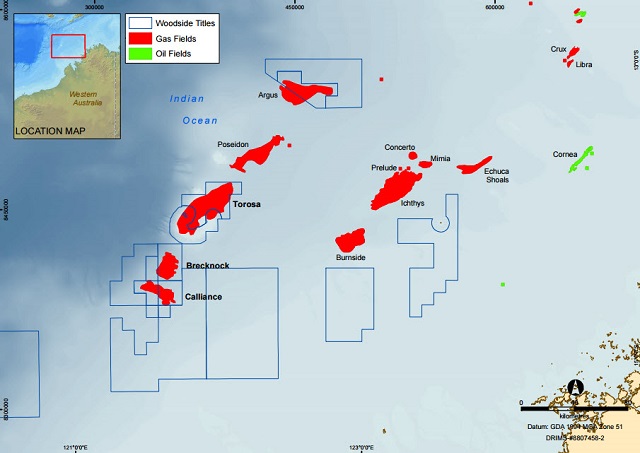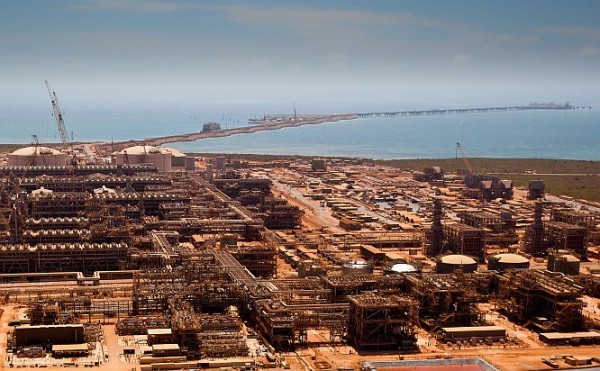Woodside Cans Australian Browse LNG Project
Woodside has issued a statement saying that the Browse Joint Venture participants have decided not to progress with the Australian Browse LNG development at this time considering the current economic and market environment.
The Browse Development concept is based on three FLNG facilities using Shell’s FLNG technology and Woodside’s offshore development expertise to commercialize the Brecknock, Calliance and Torosa offshore fields approximately 425 kilometers north of Broome, Western Australia.

Since FEED entry, Woodside has been focused on delivering targeted cost savings and value enhancements. While significant progress was made to improve project value, this has been offset by an extremely challenging external environment, said the statement.
Woodside CEO Peter Coleman acknowledged the high quality of technical and non-technical work completed on the Browse FEED program to enable the Browse Joint Venture participants to reach this decision.
“We have undertaken a comprehensive and rigorous process to assess all elements of the development. The decision represents a disciplined approach to large-scale capital investment and is consistent with our requirements for a development concept to be commercially robust across a range of scenarios.
“Woodside remains committed to the earliest commercial development of the world-class Browse resources and to FLNG as the preferred solution, but the economic environment is not supportive of a major LNG investment at this time. Accordingly, we will use the additional time to pursue further capital efficiencies for Browse,” he said.
Woodside will now work with the Browse Joint Venture participants to prepare a new work program and budget to progress development activities. Woodside intends to leverage the high quality work delivered to date, which includes the involvement of the State Government to agree key principles for domestic gas and supply chain arrangements and the State and Commonwealth Governments to manage maritime boundary changes.
Woodside remains focused on satisfying its work program commitments under the Browse retention leases. The Browse retention leases were renewed in 2015 and the current term of the leases ends in mid-2020.
Woodside’s participating interest in the Browse resources is 30.6 percent (net Woodside 2C share of 4.9 trillion cubic feet of dry gas and 142.6 million barrels of condensate).
Project Delays in Australia

In February 2016, U.S. oil major Chevron announced that the first exports from Australia’s Wheatstone offshore gas project will be delayed from later this year to the middle of 2017.
The $29 billion Wheatstone Project is one of Australia’s largest resource projects. It is located at Ashburton North, 12 kilometers west of Onslow in Western Australia. The project will consist of two LNG trains with a combined capacity of 8.9 million metric tons per annum and a domestic gas plant.
Wheatstone is a joint venture between Australian subsidiaries of Chevron (64.14 percent), Kuwait Foreign Petroleum Exploration Company (13.4 percent), Woodside Petroleum Limited (13 percent) and Kyushu Electric Power Company (1.46 percent), together with PE Wheatstone Pty Ltd, part owned by TEPCO (eight percent).
After the Chevron announcement, Woodside said that the Julimar project, which will supply gas to the Wheatstone onshore plant, remains on schedule and on budget. Woodside has a 65 percent equity interest in the Julimar project and is operator of the development.
Gorgon Leads Growth

Australia took another significant step towards becoming the world’s largest exporter of LNG with first production from the massive Gorgon Project off Western Australia early in March 2016.
At the time, industry body APPEA Chief Executive Dr Malcolm Roberts congratulated operator Chevron and its joint venture partners ExxonMobil, Shell, Osaka Gas, Tokyo Gas and Chubu Electric Power on the achievement.
Dr Roberts said Gorgon was the latest project in a wave of unprecedented LNG investment that would deliver enduring benefits for all Australians. “Gorgon is the largest single resource project ever developed in Australia and one of the world’s largest natural gas projects,” Roberts said.
“The economic benefits to Australia during its construction have been enormous – more than 10,000 direct jobs and more than $34 billion spent on local goods and services. But the long-term benefits will be even greater. Gorgon is expected to generate GDP growth of more than $440 billion over the next two decades of operations and additional federal revenue of around $69 billion.
“Every shipment of gas that sails from Barrow Island means more wealth for Australia and more cleaner-burning energy for Asia.”
Roberts said Australia was reaping the benefits of $200 billion worth of new investment that would see LNG exports surge from 30 million tons last year to more than 85 million tons by 2020.
Four new LNG projects have entered production since 2014 (Queensland Curtis LNG, Gladstone LNG, Australia Pacific LNG and Gorgon) and another three are still under construction (Prelude Floating LNG, Wheatstone and Ichthys).
Dr Roberts said the industry’s growth has put Australia on track to overtake Qatar as the world’s largest LNG exporter in 2018.
